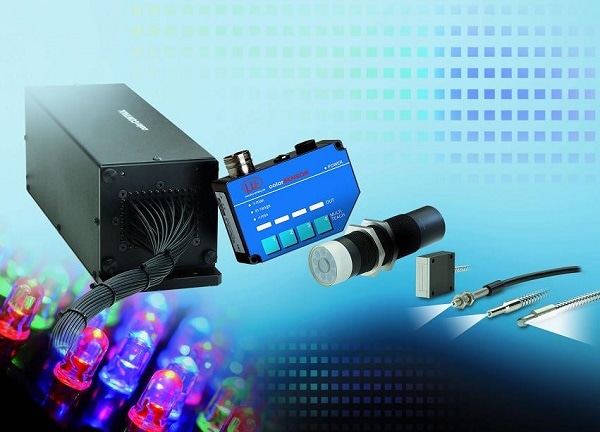Precision sensor manufacturer Micro-Epsilon is now able to offer customers in the UK one of the widest ranges of colour recognition sensors, LED analysers and inline colour measurement systems in the world – available from a single source.

LED analysers
Benchtop multi-point measurement systems enable faster, easier inspection of light-emitting diodes (LEDs). The colorCONTROL MFA series from Micro-Epsilon starts with a basic version that offers five measuring channels. The colorCONTROL MFA-5 is extremely compact and can verify the colour, intensity and colour temperature (in Kelvin) of up to five LEDs simultaneously. The measuring system is modular and so can be extended by adding extra MFA-E modules in batches of five channels, up to a maximum of 4 modules (i.e. 20 channels).
The MFA is suitable for a wide range of applications, including LED tests (binning), indication and displays, front panels, dashboard sequence tests, self-luminous object inspection. The MFA series is suitable for all manufacturers and developers of LED luminaires, including architectural and street lighting, and LED lighting for automotive interiors.
Colour sensors with optical fibres
The colorSENSOR LT range of sensors operate using optical fibres. The sensor is connected to an optical fibre that is guided to the measurement target. Colour detection therefore takes place very close to the object, which reduces any environmental effects that could adversely affect the reliability of measurements. More than 2,000 different types of fibre optic cable are available to choose from, as well as a large number of lenses. These provide customers with an almost unlimited number of combinations of sensor and optical fibre, which in turn enables Micro-Epsilon to help customers select the most optimum colour recognition sensor for their application.
The colorSENSOR LT range includes low cost, entry-level sensors through to high precision, multi-channel colour recognition systems. The LT range offers measuring distances from 2-200mm and up to 255 colour memory locations. As well as exact colour, these memory options enable the user to store specific tolerance limits for different applications. During colour recognition inspection, the sensor compares the colour it has been taught with the colour currently detected. The results are then made available via digital interfaces (RS232 or USB) as discrete values/numbers or NO/NOK statements. The sensors are supplied with their own set up and configuration software and a graphical user interface that enables the user to adjust the sensor to suit different applications.
Using new LED light sources, LT sensors can now be mounted much further away from the measurement target if required, at distances of up to 900mm.
Integrated optics and illumination
Micro-Epsilon’s colorSENSOR OT series of colour recognition sensors operates by using fixed optical systems. These sensors are able to recognise the colour of objects from longer distances (from 2mm to 800mm). Different models are available to suit different surfaces and materials, including shiny, reflective and structured surfaces, as well as versions for recognising UV markings. OT sensors can even recognise colour variations along or between target objects and materials. This is particularly beneficial to manufacturers of vehicle interiors, leather, embossed film, fabrics, wood veneers and large painted components, where the smallest colour variation is deemed unacceptable by the customer.
OT sensors use nine white-light LEDs, whose brightness can be controlled as required. These LEDs are used as light sources for diffuse illumination. The switching status is displayed using five yellow LEDs. The sensors are insensitive to external light and have a true colour detector that filters XYZ values in a similar way to the human eye. However, a ‘best hit’ mode uses vector formation to show colours that are so similar that they are almost indistinguishable to the human eye. This provides customers with unambiguous, process-safe colour differentiation.
Adaptive learning
All sensors in Micro-Epsilon’s colorSENSOR range benefit from a ‘teach-in’ function. This enables the sensor to learn and adapt to the application by using samples of the correct colour. Following this process, the sensor is able to compare the colour samples it has been taught with the target object, then operating independently.
In-process colour measurement
Many applications require colours and shades to be examined on-the-fly and to very high accuracies. The colorCONTROL ACS7000 from Micro-Epsilon is an inline (in-process) high speed colour measurement system that measures the actual colour of the target by identifying their coordinates in the colour space. The system identifies colours using any of the XYZ; L*a*b*; L*u*v*; RGB and DIN99 measurement definitions (user selectable). The system can be set up to continually monitor a production process and output the colour measurement via Ethernet, EtherCAT or RS422 and can also be taught pass fail/limits and then output out-of-tolerance alarms using digital I/O.
Existing applications for the colorCONTROL ACS7000 include automotive paint inspection, colour measurement of car interiors, coloured glass, transparent film and sheet production, printing, packaging, medical technology, food, cosmetics, pharmaceuticals and in the processing of plastics, food, wood, paper, veneer and textiles. The system is equally suitable for offline R&D laboratory applications.
For more information on colour sensors from Micro-Epsilon, please call the sales department on 0151 355 6070 or email [email protected]